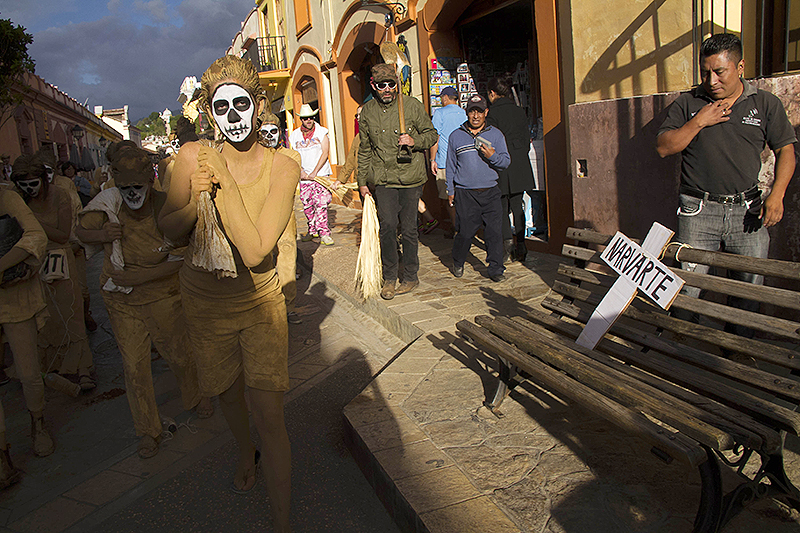IN FOCUS: Guerrero – The multidimensional violence at nearly a year after the forced disappearance of the normal rural students of Ayotzinapa
06/09/2015
ARTICLE : The many forms of fighting: walking, illuminating, and planting
06/09/2015“Because now, as for some time already, we see lights being lit in many corners.
They are lights of rebellion and resistance.
Sometimes they are small, like ours.
Sometimes they are big.
Sometimes they shine for a long while.
Sometimes they are only a spark that quickly goes out.
Sometimes they go on and on without losing their glow in our memory.
And in all of these lights there is a wager that tomorrow will be very other”.
(EZLN, January 1st, 2015, Oventik)
This year is the anniversary of the International Service for Peace (SIPAZ). After its foundation in 1995, after the armed uprising of the Zapatista Army of National Liberation (EZLN) and in response to Bishop Samuel Ruiz´s call to international observation to stop the repression of indigenous communities, 2015 marks the 20th year of SIPAZ´s presence in Mexico. Two decades later, today we continue working to deterrent and prevent the socio-political violence, not only in Chiapas, but also in Oaxaca and Guerrero.
We believe the physical permanency of 20 years of SIPAZ in Mexico is something to celebrate. A couple of decades in international accompaniment has given us countless experiences. For this reason, we decided that the anniversary was to be a key moment to stop and recollect the main lessons learned during this journey with civil organizations, social movements, and organized defense processes that work daily to construct a better world. SIPAZ has had the privilege of accompanying many of them.
Willing to share the lessons learned, we are in the process of elaborating various materials. As mentioned in the previous report, we are preparing a book about the situation of women in the last 20 years in Chiapas: the changes, or not, in the life of women; in their participation opportunities and in their collective imaginary, as well as their organized actions and learnings. Aside from this material, there are other products we are making about social processes that we have accompanied so far. The first is a documentary video that shows three of them that are organized in defense of their rights and territory in Chiapas and Oaxaca. The second product is a book that compiles the general lessons of the struggles and resistances accompanied by SIPAZ from the perspective of non violence. Both materials will be presented in an internal forum “20 Years Accompanying Lights of Hope”, that will take place at the end of November. We have hope that it will be a festive space and a gathering of these accompanied lights of hope, giving them an opportunity to share reflections, feelings and critical thoughts.
This work has a double-objective. Firstly, it is an exercise of reflection for SIPAZ to evaluate our actions in the long run, the relevance of our strategies in relation to the changes of the context, enabling us to make the adjustments that might be needed. Secondly, we want to provoke the “contamination of good examples”. We believe that other persons, struggles, and resistances can find models of inspiration in these materials so as to take their own steps towards the horizon they have chosen, in their own time and in their own geography. We believe that visualizing actions towards justice, as small as they might be, contribute in raising hope and encouraging others so that they may contribute their own grain of sand in this collective construction of Peace with Justice.
In these 20 years we have lived great cries such as “¡ya basta!” (Enough) of the EZLN in Chiapas (1994), “Voto por voto, casilla por casilla” (vote for vote, poll station for poll station) of Andrés Manuel López Obrador (2006), “¡hasta la madre!” (more informal way to say enough) of the Movement for Peace with Justice and Dignity (2011), “¡ya no!” (not any more) of Mireles and the auto-defenses in Michoacán (2012), or “it was the state” of Ayotzinapa in Guerrero (2014). They have all served so as to not let ourselves be indifferent before the hardness of reality. We intend that the knowledge we share will promote reflection on where each of one of us stand and what our role might be in constructing peace, justice, and dignity. We believe that struggles require organization that brings together the efforts of everyone towards achieving what native peoples in Chiapas call the lekil kuxlejal, or the “good life”. As the compañeras and compañeros of the EZLN shared with us in the Seminar “Critical Thought Versus the Capitalist Hydra”: what about you?.
